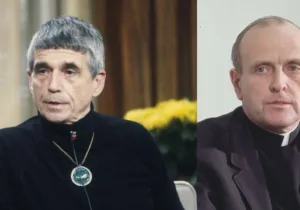On the fifth day of Iyar on the Hebrew calendar—originally corresponding with May 14, 1948—David Ben-Gurion, the executive head of the World Zionist Organization and the chairman of the Jewish Agency for Palestine, declared the establishment of the State of Israel. Seventy years on, Israel celebrates yet another milestone anniversary.
Her existence has never been a sure thing. Even prior to her inception, Israel found herself in an existential fight. In 1947, the United Nations proposed the end of British rule in Palestine and the division of the land into a Jewish state, an Arab state, and an internationally controlled area surrounding Jerusalem. Zionists, desperate to enable the immigration of Jewish refugees displaced by their attempted destruction in Hitler’s Europe, accepted the UN plan—even if some did so with an eye on future territorial expansion. The Arabs outright rejected it. And so, the end of 1947 and the beginning of 1948 was marked by what was essentially a civil war as Jewish settlements and neighborhoods were attacked by Arab guerrillas. When, on the heels of the Israeli rout of their Arab opponents—and on the eve of the British departure from the region—Ben-Gurion made his proclamation, and the combined armies of Egypt, Lebanon, Syrian, Jordan, and Iraq attacked.
Recall: In 1948, the Jewish population of Israel was less than 900,000. At her narrowest, Israel was nine miles wide, and she was surrounded by some 639 miles of hostile neighbors hellbent on murdering her in the cradle.
Israel’s victory in her first war came at an extraordinary cost. More than 6,000 Israelis died. The number, however, obscures the price. Given her population at the time, Israel’s war dead totaled 1 percent of her population. At the time, this would have been the proportional equivalence of 1,000,000 Americans. Today, this would be more 3,000,000 Americans.
The ongoing fee exacted for the continuing existence of Israel has remained consistently high. In The Liberal Oasis: The Truth About Israel, Joshua Muravchik calculates the grim tally: The 1967 war would kill nearly 800 Israelis (the equivalent of 50,000 Americans); just six years later, the 1973 war would cost some 2,700 more (the equivalent of another almost 200,000 Americans); the 2000 intifada would slaughter another 2,000 (the then equivalent of 50,000 Americans); through it all, some 5,000 Israelis were killed in innumerable minor skirmishes and terror attacks—another 250,000 in equivalent American proportions.
In light of this accounting, it is no wonder that Israel’s Independence Day—Yom Ha’atzmaut—is always preceded by Yom Hazikaron, Israel’s Memorial Day. Linking the two days signals a moral imperative: never forget that the life of the nation has been sustained by the lives of her people.
From the first breaths of the Jewish State, a sense that national existence is at stake has rightly suffused the Israeli mind. More than simply a war for self-determination, the Israeli War of Independence was a battle for survival. Moshe Dayan, then commander of the Jerusalem front, said, “All knew that there could no retreat and no surrender.” In Israel, common threats have always bred common cause. Unity, therefore, was found in the recognition that there were—and too often are—no alternatives to force, power, and military prowess. In 1948, to the question of whether it was in Israel’s power to stand up to the Arab assault, the common retort was, “Is it in our power not to?”
This realization has been perpetually renewed. Years on, reminiscing about the Yom Kippur War, former Prime Minister Golda Meir articulated the mood of the time. “We know,” she insisted, “that giving up means death, means destruction of our sovereignty and physical destruction of our entire people…against that we will fight with everything that we have within us.”
Seventy years on, Meir and Dayan’s necessary resolve calls to mind the imperative proclaimed years earlier by Ben-Gurion. “God left one commandment out of the Bible,” he mused. “Perhaps the Almighty delivered this commandment to Moses, but Moses forgot to bring it down from the mountain. That commandment is No. 11: ‘Be strong.’”
And yet, strength in the hands of Israel has—most often—been characterized by a remarkable degree of restraint. The truth of this—seemingly wild—claim is suggested by a simple test. A fair accounting of the facts on the ground would agree, it seems self-evident to me, with the proposition that if Israel’s enemies were to lay down their weapons there would be peace between Israel and her Arab neighbors, but if Israel were to lay down her arms, there would be no Israel.
Even Dayan, the paradigmatic Jewish warrior, one whose name is counted with Joshua and Gideon, was a man who warred for the sake of peace. He fought and killed, but he didn’t hate. Dayan’s childhood was spent among Arab neighbors. Bedouin children were his early playmates. He boasted of his deep respect and affection for his Arab friends. “We took our lunch together among the furrows,” he said. “I danced at their weddings and they danced at mine.” Even when his brother was killed by Syrian Druzes during the War of Independence, Dayan sought reconciliation. He called the men who had killed his brother to a parley and put to them the case that they would be better off being a part of Israel than of Syria. Dayan recalled that, for those Druze tribal warriors, blood-for-blood was the eternal law and “they could not believe that one whose brother had been shot down only days earlier could extend the hand of amity to those who had taken that brave man’s life.” But extend the hand Dayan did, and “those men became my friends.” If I’m right, this is what enemy-love looks like.
At the same time, point two, to acknowledge the reality of enemy-love is to acknowledge the reality of an enemy. Because the Arabs hate the Jews, Dayan insisted the Jews cannot ignore the hatred. We can clamor for peace all we want, but our enemies always have a vote in the mater. And so hardheaded realism must always trump softhearted sentiment.
For Dayan, Jewish strength was found first in a willingness to yield, when yielding serves the long-term good of all. “We must be strong enough to see the other fellow’s side,” he urged, “to act with clemency, to extend the hand of friendship.” At the same time, our enemy’s implacability means our open hand must sometimes be closed to a fist. And then strength, in the last resort, takes the form of Samson, and we break apart the strongholds of our adversaries.
Years later, when Dayan stood triumphant at the Kotel, the Western Wall newly liberated in the ’67 War, his radio statement revealed, yet again, this magnanimous spirit. He said:
To our Arab neighbors, we extend, also at this hour—and with added emphasis at this hour—our hand in peace. And to our Christian and Muslim fellow citizens, we solemnly promise full religious freedom and rights. We did not come to Jerusalem for the sake of other people’s holy places, nor to interfere with believers of other faiths, but in order to safeguard its entirety, and to live here together with others, in unity.
It is in light of this full spectrum of Israeli history and intentionality that the present violence on the Gaza border should be viewed. Given the catalog of existential threats long waged against her, it is asinine in the extreme to claim, as some have, that Israel is in the wrong on the Gaza frontier for no other reason than that the deaths have been so one-sided. History—read the intractability of those who mean to destroy her—has taught Israel that she must only ever fight decisively with a will to win—lest she ceases to be able to fight at all. Israel, for all her strength, remains vulnerable. If she ever finds herself in a fair fight, she had better change her tactics quickly.
Human rights groups are petitioning Israel’s Supreme Court to challenge the legality of the Israel Defense Forces’ live fire rules. They insist the only legal justification for using live ammunition against civilians is if they are “posing an imminent danger to the lives of others.” What’s so frustrating is that the same groups recognize that those being killed are most often shot while trying to breach the security fence—as was Wisal Sheikh Khalil, a 14-year-old girl killed while trying to break through the fence with wire cutters. For the activists, what the poor girl was doing is, apparently, beside the point. The fence, they insist, simply does not have the “same importance [as] the life of a 14-year-old.”
This is ridiculous. Presumably, not even these activists are silly enough to believe that the Palestinian rioters have peaceable activities in mind should they succeed in breaching the fence. Therefore, how a concerted effort to rush Israeli territory does not pose “an imminent danger” is unclear. The danger posed to Israel seems especially plain in light of frank admissions by Hamas that the protests have nothing to do with peace.
The question that needs to be asked is what a poor 14-year-old girl is doing with wire cutters on the Gaza border in the first place. I venture to guess that the human catastrophe in Gaza—the heartbreaking reality of daily life—will be much alleviated when Hamas militants love their own Palestinian people more than they hate the Jews. Love for their own should have compelled them to keep children away from the fight. I can only assume it was their preference for provoking anti-Israeli propaganda that pushed them to deploy kids.
And yet, however tragic the events on the Gaza frontier are, there’s one fact that mustn’t be lost in the mayhem. The violence on the Gaza border is, well, pretty much just that—the violence on the Gaza border. It’s telling that there is no comparable violence in the West Bank, nor along so much of the vast majority of that 639-mile-long border that, a scant seven decades ago, was lined with those who intended to drive Israel into the sea. It’s enough to make one suspect that Israel’s sworn enemies are diminishing and that the fact of Israel’s existence has increasingly become an accepted one.
—
Marc LiVecche is executive editor of Providence.
Image Credit: Eretz Israel, by Marc Chagall. Location: The Chagall State Hall, The Knesset. Used for state receptions in Israel’s parliament building, the state hall was designed and decorated by the Jewish artist Marc Chagall (1887-1985). Chagall designed for the hall 12 floor mosaics, one wall mosaic, and three Gobelin tapestries. The tapestries were ordered in 1965 and were produced over a period of four years. The work is presented in the form of a triptych (a picture made up of three parts), in which each of the parts is both part of the whole and a separate unit. The central tapestry, pictured here, expresses the connection between the people of Israel and its God with Eretz Yisrael, and the attachment of the people of Israel to the idea of the ingathering of the exiles. The central figure on this tapestry—Moses—is seen twice: during the giving of the Law and during the traveling of the people to the promised land. The tapestry describes various events from the history of the people of Israel in the diaspora, from the exit from Egypt to a description of the burning village, which symbolizes the Holocaust, as well as the priest Aaron, facing the seven branch candelabrum—representing the State. In addition, King David is seen playing the harp, and behind him is the bride—the virgin of Israel. Source: M. LiVecche.







 Sponsor a student for Christianity & National Security 2024
Sponsor a student for Christianity & National Security 2024